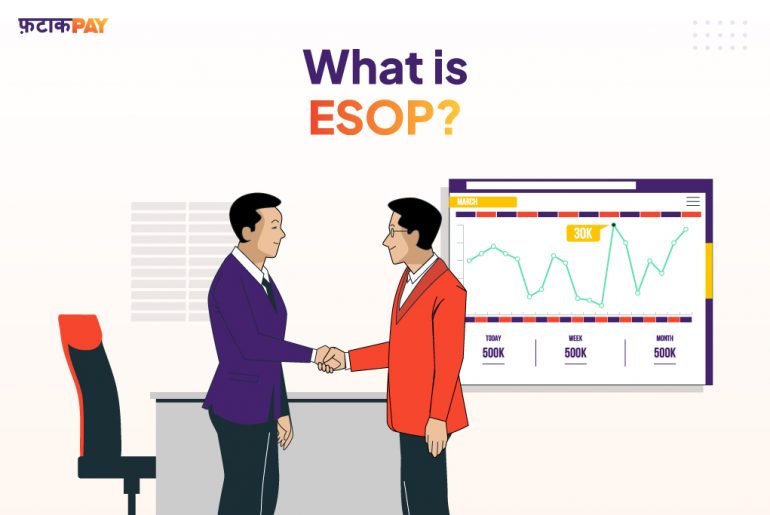Introduction to ESOP:
First off, an employee of a company who participates in an Employee Stock Ownership Plan (ESOP) has the option to purchase the company’s shares at a reduced price after a specified number of years. This occurs frequently in start ups. The Employee Stock Option Plan (ESOP), sometimes known as a rewards program, was created by HR and financial experts.
The contract restricts the purchase of the shares to the end of a term known as the vesting period. Given his ownership in the business and the potential benefits it offers, this assures the employee stays with the organisation.
More about ESOP:
The employee has the option but not the obligation to purchase company stock.
Only after the vesting period, which is a certain number of years, may ESOPs be exercised. With the chance to purchase shares at a discount, this holding term makes sure the employee stays with the company.
The number of shares purchased could be all of the shares covered by the contract or just a portion of the exercisable rights.
Until the owner of the ESOPs decides to liquidate, or simply sell, the shares, the gains or losses do not appear on paper. When an employee leaves the company or retires, an ESOP is considered to be liquidated.
The first step for the business considering an ESOP as a rewards pathway is to establish a trust. A trust is a kind of business that promotes a particular purpose or benefit. The business contributes money to the trust either through debt (loans obtained through various methods) or its own resources (equity).
The trust then uses the funds it has collected to purchase shares and acts as a holding structure for those shares. What is a trust capable of?
1. Give new hires and current employees shares of stock
2. Purchases shares from departing employees.
In the process, the trust serves as the company’s fiduciary. Because the company has faith in the newly formed entity, the trust has a fiduciary duty to handle the shares in the company’s best interests.
Who gets ESOP?
It’s important to keep in mind that ESOPs are only provided to a small number of workers, often Key Managerial Personnel (KMP).
Every company has a unique method for distributing ESOPs to its employees. The basis is typically an employee’s grade, contribution to the organisation, and term of employment with the organisation.
You qualify for ESOPs if you click any of the following boxes:
1. A full-time employee of your company or one of its subsidiaries
2. Board of directors
3. A director who is also an investor or advisor
4. Entrepreneurs who are accredited by the Department for Promotion of Industry and Internal Trade (DPIIT) as founders or promoters
Variations in ESOPs:
- ESOPs are referred to as unlevered when the shares are raised through equity.
- Leveraged ESOPs are used when the shares are raised through debt.
- The number of stocks increases as a result of measures like stock splits or bonuses that dilute existing ESOPs.These shares are called ESOPs through issuance.
Benefits for Employees:
Employee stock ownership plans (ESOPs) encourage workers since they provide a future source of income in exchange for continuing to work for a firm and supporting its expansion. Workers associate this with their efforts and view the program as providing a positive return.
ESOPs continue to serve as a means of asset diversification. When one purchases and sells the stock at a premium to the purchase price in the future, this will provide an additional cash boost.
Employees start keeping a careful eye on the company’s valuation, which will impact the stock price. This naturally drives them to synchronise their objectives with those of the company. The aggregate performance of the individuals who make up the firm has an impact on its performance. The value of the stock increases as the employees perform better.
Benefits for Employers:
On the other hand, the company’s retention rate increases as a result of employees sticking around longer to take advantage of discounted shares after the vesting period.
The program’s design can entice elite people to head up new businesses. Young businesses with limited liquidity would be unable to hire top talent or specialised personnel. They can access the talent pool they want through ESOPs.
Employees are motivated to perform at their highest level because they have a stake in the company thanks to ESOPs. They tend to spread the word about the good things while doing this. Additional publicity benefits the marketing department greatly, in addition to offering the staff members a compelling reason to stick around.
Because the promoters’ contributions to the ESOP would not be more than their contributions to the company, the corporate structure would not be impacted by the ESOP model.
Importantly, ESOPs offer a tax benefit for a company’s financial outflows. The cash flows may be used for share buy-backs or to put more money in trust to purchase additional shares.
It is still possible to claim a tax deduction for the money transferred from the corporation to the trust even if its only purpose was to act as a cash reserve. In addition, ESOP loan repayments and dividend payments are also tax deductible. In conclusion, the corporation has a significant cash flow advantage.
Tax Implications for ESOPs
Think about an employee who receives shares on a certain day. The share allotment date is this specific day. According to Section 111A of the Income Tax Act of 1961, the following tax slabs will be in effect as of this date based on how long the employees have held their shares. One must consider the company’s listing status in order to distinguish between Long-Term Capital Gains (LTCG) and Short-Term Capital Gains (STCG).
| STCG | LTCG | |
| Listed Company Sales of Shares within 1 year: STCG Beyond 1 year: LTCG | 15% | 10% without indexation (i.e. adjustments for inflation) where gains exceed Rs 1 lakh |
| Unlisted Company Sales of Shares within 2 years: STCG Beyond 2 years: LTCG | Regular Income Tax slab as per income of employee | 20% with indexation |
Conclusion:
In essence, ESOPs that are properly organised benefit both the company and the employee. The firm would be able to increase its valuation while also managing to retain top people, and the employee would be able to make bigger gains on his shares over time.
About FatakPay:
FatakPay provides virtual credit facilities for all. It’s available on your phone and caters to your everyday needs in both online and offline formats. Payments are done seamlessly through UPI/QR codes. The solution provides an almost zero cost, free, quick, transparent and secure way to transact in a multilingual format with a Scan Now, Pay Later facility and easy repayment options.







